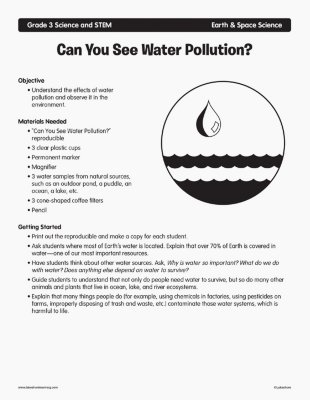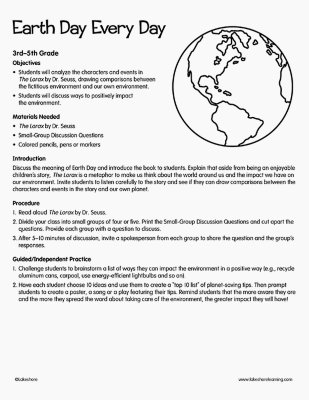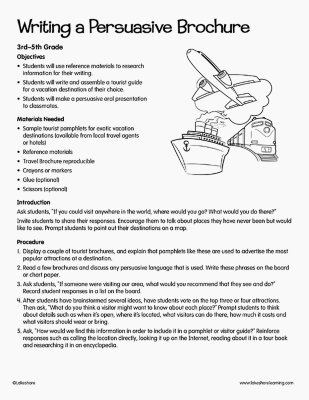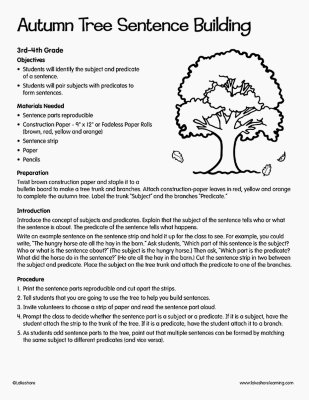Narrow by Grade
- Infant (0)
- Toddler (0)
- Preschool (0)
- Pre-K (0)
- Kindergarten (0)
- 1st (0)
- 2nd (0)
- 3rd (4)
- 4th (3)
- 5th (2)
- 6th & Up (0)
Grade
Narrow by Age
- 0-18m (1)
- 18-36m (0)
- 3 yrs. (0)
- 4 yrs. (4)
- 5 yrs. (3)
- 6 yrs. (7)
- 7 yrs. (6)
- 8 yrs. (4)
- 9 yrs. (5)
- 10 yrs. (2)
- 11 yrs. & Up (0)
Age 8 yrs.
4 results for "see"
Filters
Clear All
Can You See Water Pollution?
3rd Grade
Objective
- Understand the effects of water pollution and observe it in the environment.
Earth Day Every Day
3rd Grade - 5th Grade
Objectives Students will analyze the characters and events in The Lorax by Dr. Seuss, drawing comparisons between the fictitious environment and our own environment. Students will discuss ways to positively impact the environment. Materials Needed The Lorax by Dr. Seuss Small-Group Discussion Questions Colored pencils, pens or markers Introduction Discuss the meaning of Earth Day, and introduce the book to students. Explain that aside from being an enjoyable children’s story, The Lorax is a metaphor to make us think about the world around us and the impact we have on our environment. Invite students to listen carefully to the story and see if they can draw comparisons between the characters and events in the story and our own planet.
View Lesson PlanWriting a Persuasive Brochure
3rd Grade - 5th Grade
Objectives Using reference materials to research for their writing Introducing the topic or text they are writing about, stating an opinion and creating an organizational structure that lists reasons Providing reasons that support the opinion Reporting on a topic or text, telling a story, or recounting an experience in an organized manner, using appropriate facts and relevant, descriptive details to support main ideas or themes; speaking clearly at an understandable pace Materials Needed Sample tourist pamphlets for exotic vacation destinations (available from local travel agents or hotels) Reference materials Travel Brochure reproducible Crayons or markers Glue (optional) Scissors (optional) Introduction Ask students, “If you could visit anywhere in the world, where would you go? What would you do there?” Invite students to share their responses. Encourage them to talk about places they have never been but would like to see. Prompt students to point out their destinations on a map.
View Lesson PlanAutumn Tree Sentence Building
3rd Grade - 4th Grade
Objectives Students will identify the subject and predicate of a sentence. Students will pair subjects with predicates to form sentences. Materials Needed Sentence parts reproducible Construction Paper - 9" x 12" or Fadeless Paper Rolls (brown, red, yellow and orange) Sentence strip Paper Pencils Preparation: Twist brown construction paper and staple it to a bulletin board to make a tree trunk and branches. Attach construction-paper leaves in red, yellow and orange to complete the autumn tree. Label the trunk “Subject” and the branches “Predicate.” Introduction Introduce the concept of subjects and predicates. Explain that the subject of the sentence tells who or what the sentence is about. The predicate of the sentence tells what happens. Write an example sentence on the sentence strip and hold it up for the class to see. For example, you could write, “The hungry horse ate all the hay in the barn.” Ask students, “Which part of this sentence is the subject? Who or what is the sentence about?” (The subject is the hungry horse.) Then ask, “Which part is the predicate? What did the horse do in the sentence?” (He ate all the hay in the barn.) Cut the sentence strip in two between the subject and predicate. Place the subject on the tree trunk and attach the predicate to one of the branches.
View Lesson Plan


